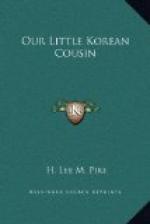A curious ceremony attended the closing of these gates. They were never shut till the king had been notified that all was well on the north, on the south, on the east, and on the west. As there were no telegraph lines, another way had to be provided by which messages might be quickly sent. Bonfires upon the surrounding hills were used as signals. By these fires the king was told if all were well in his kingdom, and every evening, as soon as the sun was set, four beacon-fires on a hill within the walls told the news as it was flashed to them from the mountains outside. Then four officers, whose business it was to report to the king the message of the fires, hastened to him, and with great ceremony and much humility announced that all was well. On this the royal band of music would strike up its liveliest airs, and a great bell would toll its evening warning. This bell was the third largest in the world, and for five centuries it had given the signal for opening and closing the gates of Seoul, the chief city of the “Land of the Morning Radiance.”
At the stroke of the bell, with a great clang the gates were shut, and strong bars were placed across the inner sides, not to be removed until at early dawn the bell again gave its signal to the keepers.
To little Yung Pak, the loud tones of the bell meant more even than to the sentinels at the gates. He knew that not only was it a signal for the closing of the city gates, but it was also a warning that bedtime was at hand.
The house in which Yung Pak lived was a very fine one, although the grounds were not as spacious as those of many houses in the outskirts of the city. But its walls were of stone, whereas many of the houses of Seoul had walls of paper.
Yes, actually walls of paper!
But this paper was a very tough, fibrous substance, and would resist quite a heavy blow as well as keep out the cold. Its slight cost brought it within the means of the poorer people.
In some parts of Korea the houses were built of stout timbers, the chinks covered with woven cane and plastered with mud. Neat hedges of interlaced boughs surrounded them. The chimney was often simply a hollow tree, not attached to the house.
Ki Pak’s house was not only built of stone, but about it were four walls of stone, about five feet high, to help keep out intruders. The wall was surmounted by a rampart of plaited bamboo. In this wall were three gates, corresponding to entrances into the house itself. One gate, the largest, on the north side, was used only by Ki Pak himself, though after he grew older Yung Pak could enter this gate with his father. The second gate, on the east, was used by the family and friends of Ki Pak. The third and smallest gate was reserved for the use of the servants.
The roof of this house was not covered with shingles, but with clay tiles, coloured red. Many houses in the city had simply a roof-covering of thatched straw.




